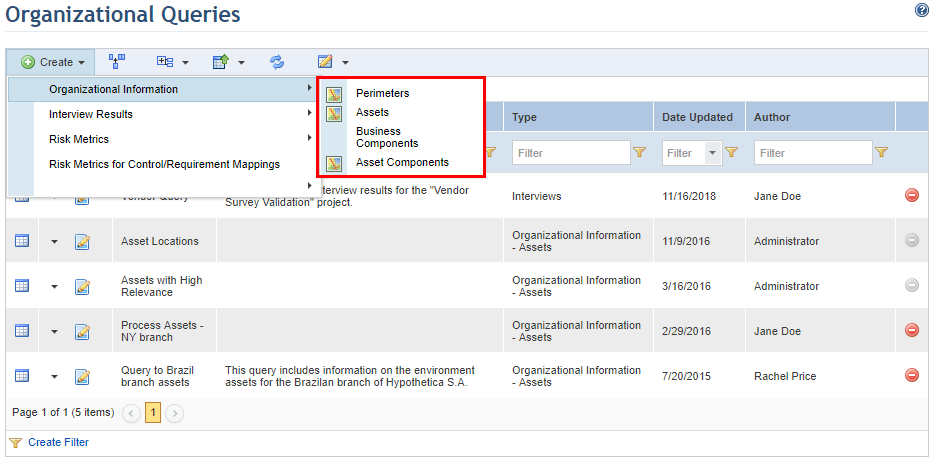
This topic explains how to create queries to display information on perimeters, assets, asset components, and business components in the organizational structure. It is important to note that these queries display information on the objects included in the scope of the query and not the results of risk analyses.
1. Access the Organization module.
2. Select List Queries from the Queries section.
3. In the Organizational Queries section, click Create.
4. Select the Organizational Information option.
The system displays a list containing the objects that can be queried (see figure below). Those whose results can be viewed through both tables and maps are indicated by the map icon to the left.

5. Select the object you want to query from the drop-down list.
The system displays the Scope step in the wizard for creating queries, where the objects to be queried can be selected (see figure below).
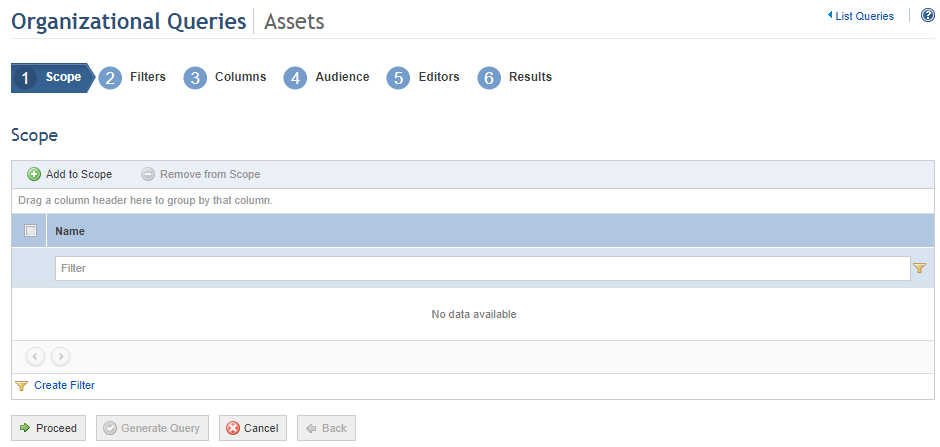
6. Click Add to Scope to select the organizational objects that will be included in the scope of the query.
In queries to perimeters, assets, and asset components, the system displays the perimeters and assets registered in the Organization module. In queries to business components, the business components registered are displayed, classified by level and type.
7.
Click Expand ( ) to view the complete structure.
) to view the complete structure.
8. Select the objects you want to include in the scope by marking the checkboxes next to each and clicking Add to Scope (see figure below). If you want to quit the operation, click Cancel.
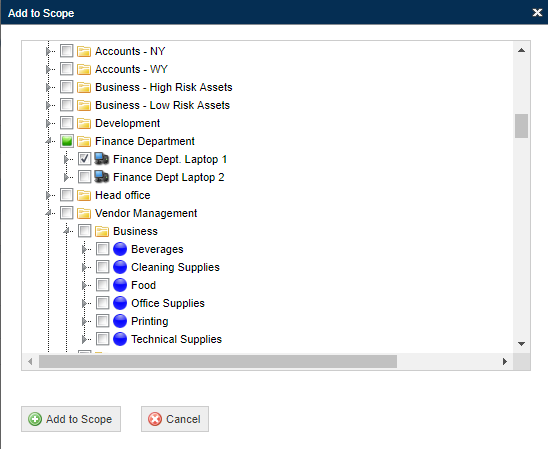
9. To remove an item from the scope, mark the checkbox next to it and click Remove from Scope.
10. When finished, click Proceed to continue creating the query. If you want to run the query, click Generate Query. If you want to quit the operation, click Cancel.
When Proceed is clicked, the system displays the Filters step in the wizard for creating the query, where the filters to be used can be selected, which will reduce the information used to display the results (see figure below).
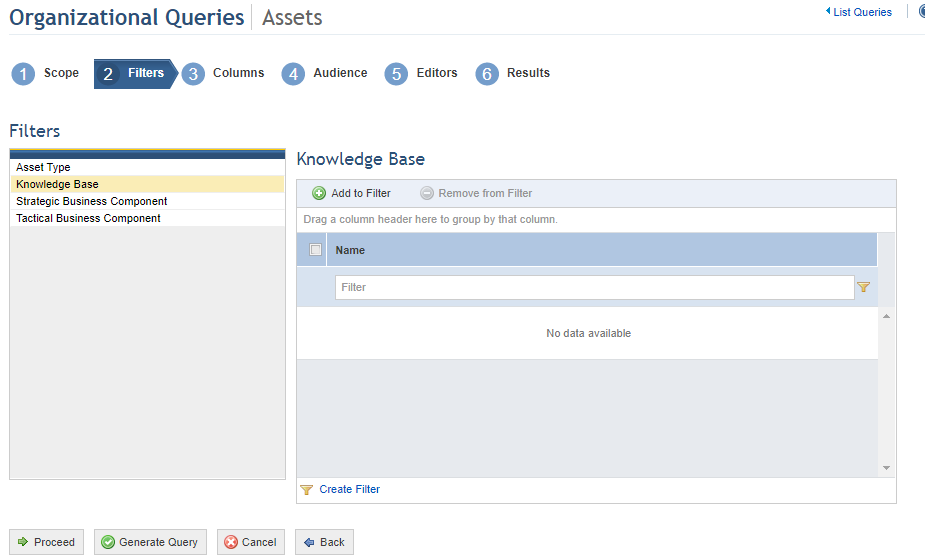
11. Select the filter you want to use by clicking one of the filter options displayed on the left (see figure below).
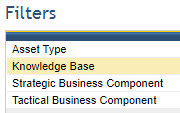
12. Depending on the filter option selected, mark the checkboxes next to the objects to be added to the filter or click Add to Filter to select the objects that will be used to filter the scope of the query (see figure below). Note that the options available vary depending on the type of filter you choose.
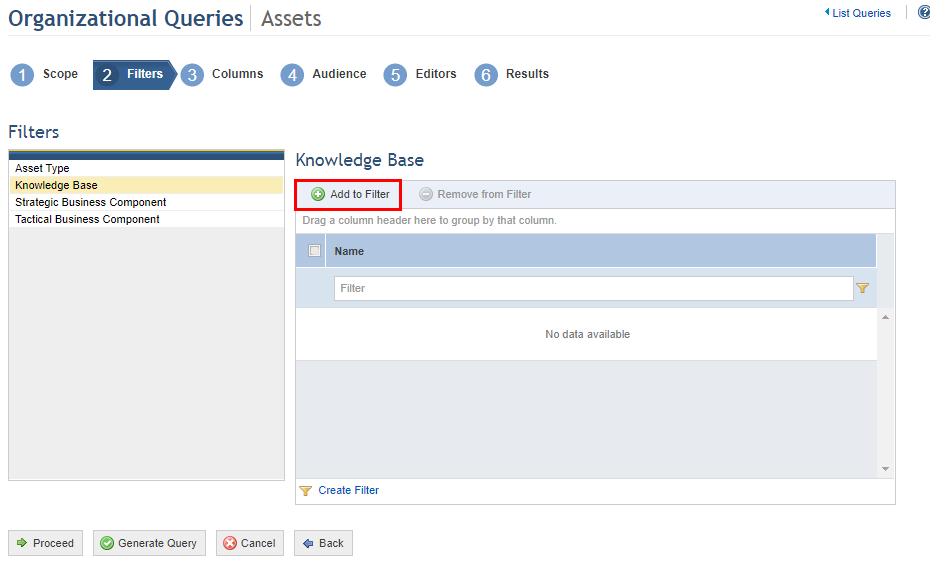
13. Select the objects to be added to the filter in the window that appears and click Add Selected (see figure below). If you want to quit the operation, click Cancel.
The system displays the objects selected for the filter.
14. To remove objects added to the filter, mark the checkboxes next to each you want to remove and click Remove from Filter.
15. After selecting the filters, click Proceed to continue creating the query. If you want to generate the query, click Generate Query. If you want to cancel query creation, click Cancel. To return to the previous step at any point during this wizard, click Back.
When Proceed is clicked, the system displays the Columns step, where the columns to be displayed in the query results can be selected (see figure below).
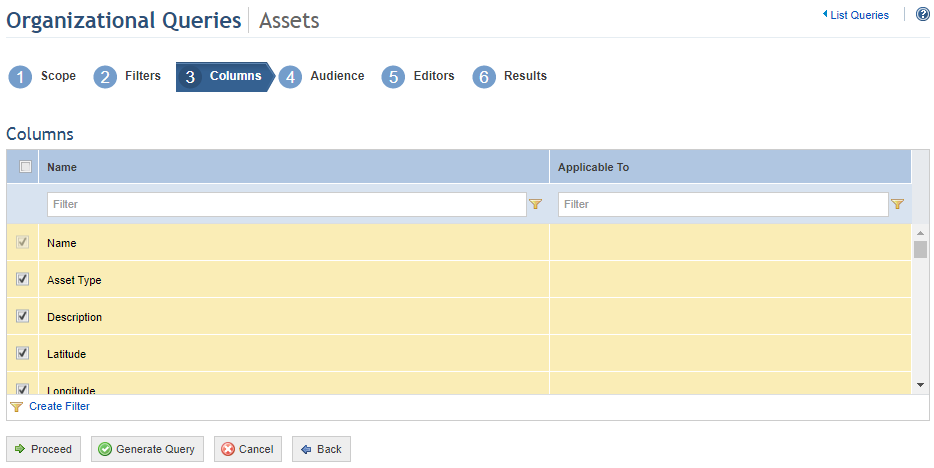
16. Select the columns you want to include in the query by marking the checkboxes next to each. By default, the system will show some pre-selected options that can be removed, while others are required columns. To remove non-required columns from the results of the query, unmark the checkbox next to each column name. To include more columns in the results, select the options that are not pre-selected by default. Note that attributes created for assets, perimeters, and business components in the Administration module are available as column options. The Applicable To column indicates which asset or business component types the attribute applies to.
17. Click Proceed to continue creating the query. If you want to generate the query, click Generate Query. If you want to cancel query creation, click Cancel. To return to the previous step at any point during this wizard, click Back.
When Proceed is clicked, the system displays the Audience step, where you can select which people and groups will be able to view the query in the Home module and in this module, if they have permission to access it (see figure below).
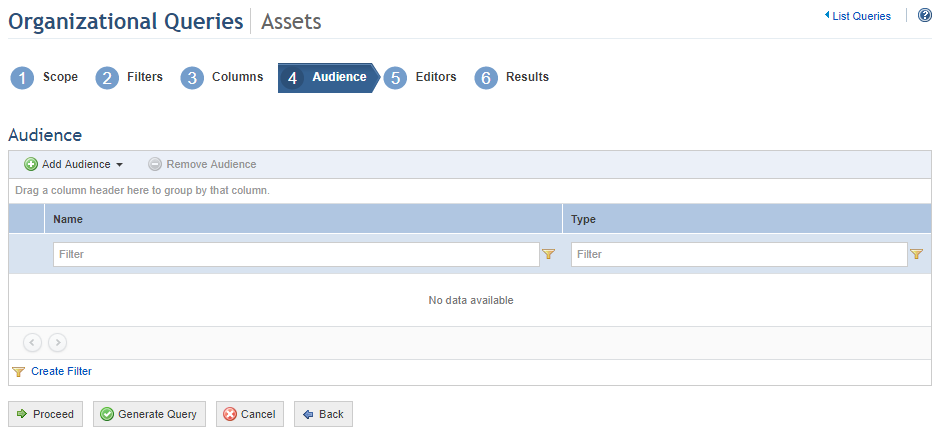
18. Click Add Audience and select People or Groups to add them.
19. If, for example, you selected People, select the people to be added and click Add People (see figure below). If you want to quit the operation, click Cancel.
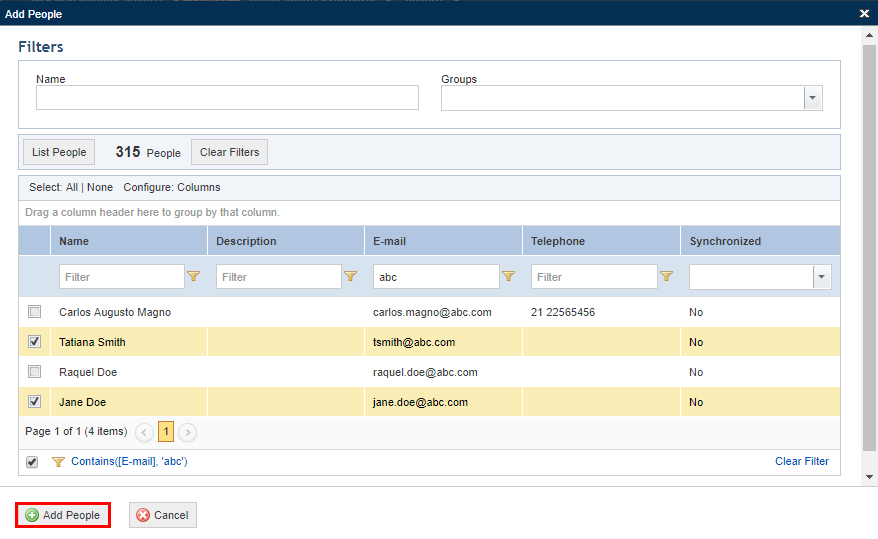
The system displays the people selected.
20. To remove people or groups from the audience, mark the checkboxes next to their names and click Remove Audience.
The system requests confirmation to remove the people or groups from the audience (see figure below).
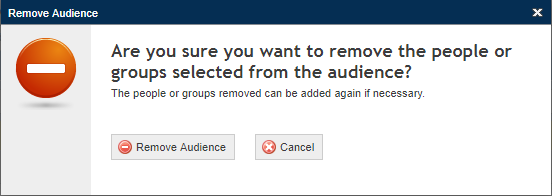
21. Click Remove Audience to confirm. If you want to quit the operation, click Cancel.
The system removes the people selected from the audience.
22. Click Proceed to continue creating the query. If you want to generate the query, click Generate Query. If you want to cancel query creation, click Cancel. To return to the previous step, click Back.
When Proceed is clicked, the system displays the Editors step, where you can select which people and groups will be able to edit the query, receiving the same permissions to it as the author (see figure below).
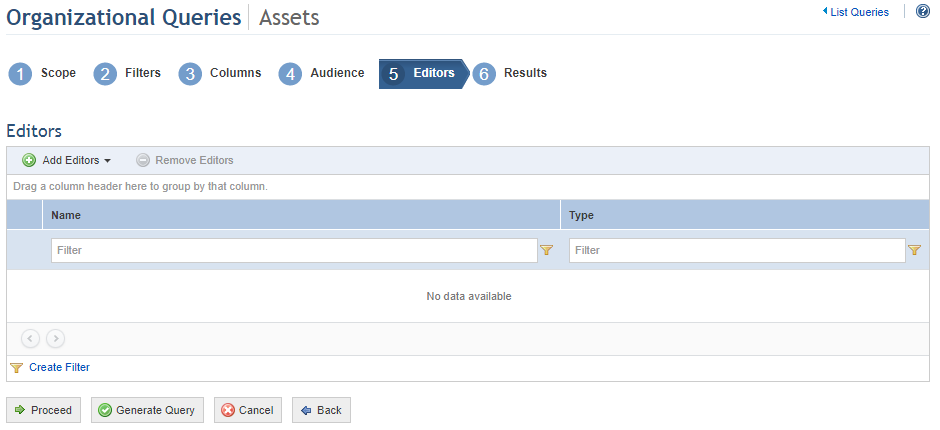
23. Click Add Editors and select People or Groups to add them to the list of editors.
24. If, for example, you selected People, select the people to be added and click Add People (see figure below).

The system displays the people selected.
25. To remove people or groups from the list of editors, mark the checkboxes next to their names and click Remove Editors.
The system requests confirmation to remove the people or groups from the list of editors (see figure below).
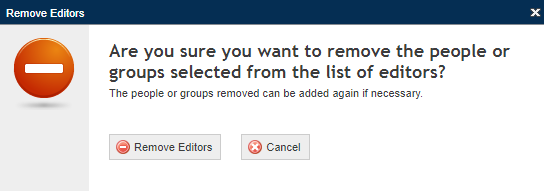
26. Click Remove Editors to confirm. If you want to quit the operation, click Cancel.
The system removes the people selected from the list of editors.
27. Click Proceed or Generate Query to run the query. If you want to cancel query creation, click Cancel. To return to the previous step, click Back.
When Proceed is clicked, the system displays the results of the query (see figure below).
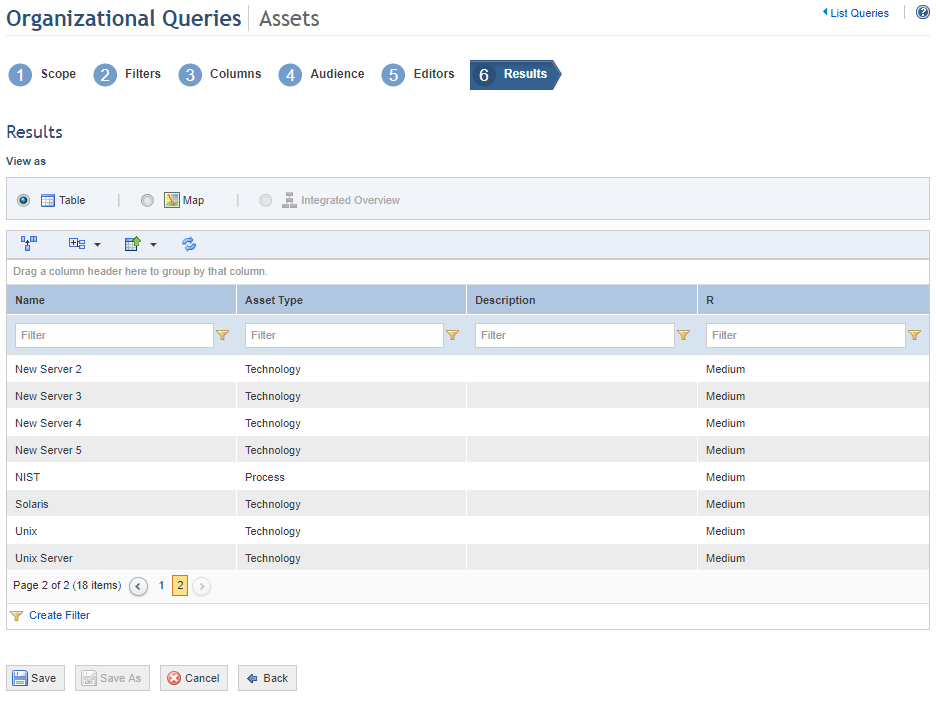
Note: The results of queries to perimeters, assets, and asset components can be displayed on a map. However, for there to be results to display, at least one of the objects in the scope of the query must have a specified location in the Organization module. An alert is displayed if no geographic locations were specified for the objects added to the scope. Keep in mind that the option to display maps must be enabled in the Display Options section of the Administration module. An internet connection is also required, otherwise an alert will appear and the map will not be displayed.
28. Select the Map option to view the results on a map (see figure below).

29. To view information contained in the columns selected when the query was created, click the pin on the map for the object whose details you want to view.
The system displays an info window containing the information selected in the Columns step (see figure below).
30.
To close the window, click Close ( ).
).
31. Click Save to save the query data. If you do not want to save the query, click Cancel. To return to the previous step, click Back.
Note: You can save the query so that its results are displayed on a table or on a map when it is run in the future. This depends on how the results were being shown when the query was last saved. For example, if the results were being displayed on a map when the query was saved, they will be displayed on a map when it is run. In addition, the zoom level and position of each map can be saved in this step, defining how the map will appear when the query is run. By default, the zoom level will be set in order to include all objects in the scope, displaying them at the closest possible range.
When Save is clicked, the system displays a window where a name and description for the query can be entered (see figure below).
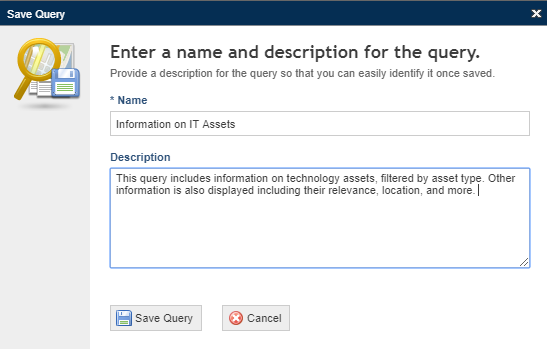
32. In the Name field, enter a name to identify the purpose and reach of the query.
33. In the Description field, enter the main characteristics of the query.
34. When finished, click Save Query. If you want to quit the operation, click Cancel.
The system displays a success message.